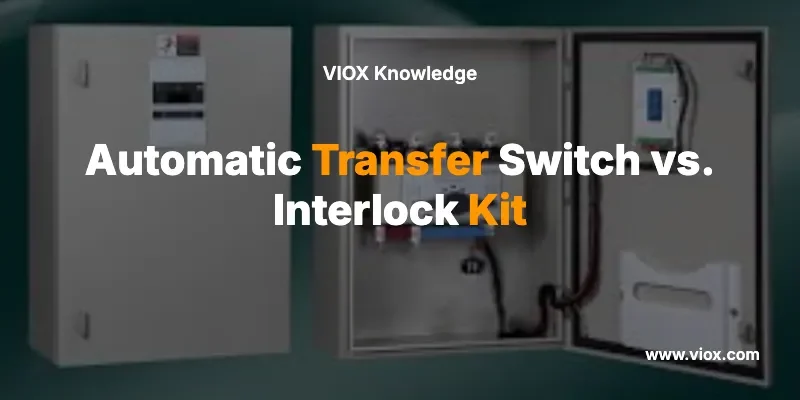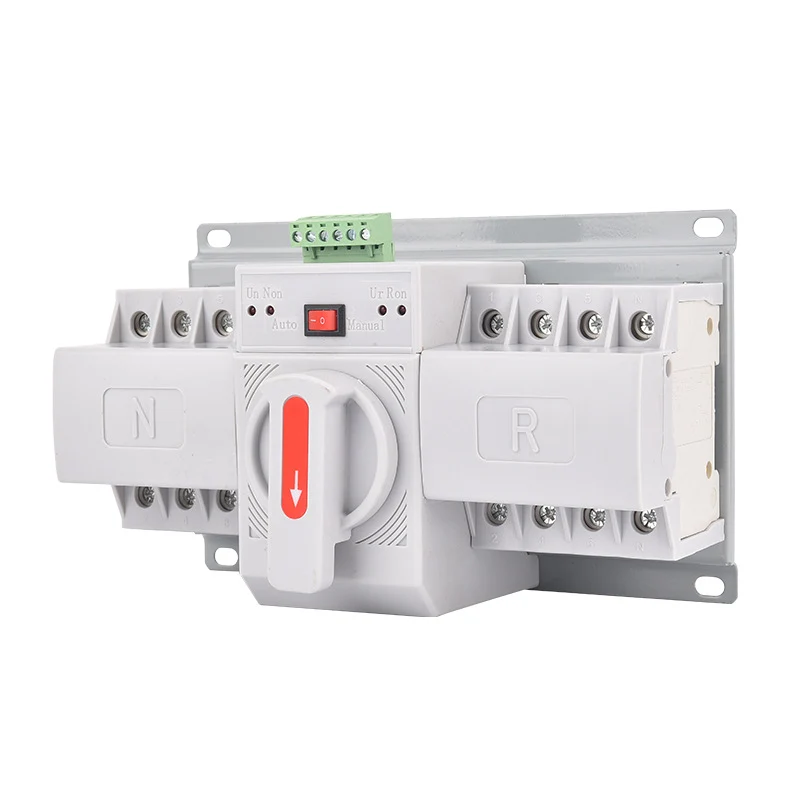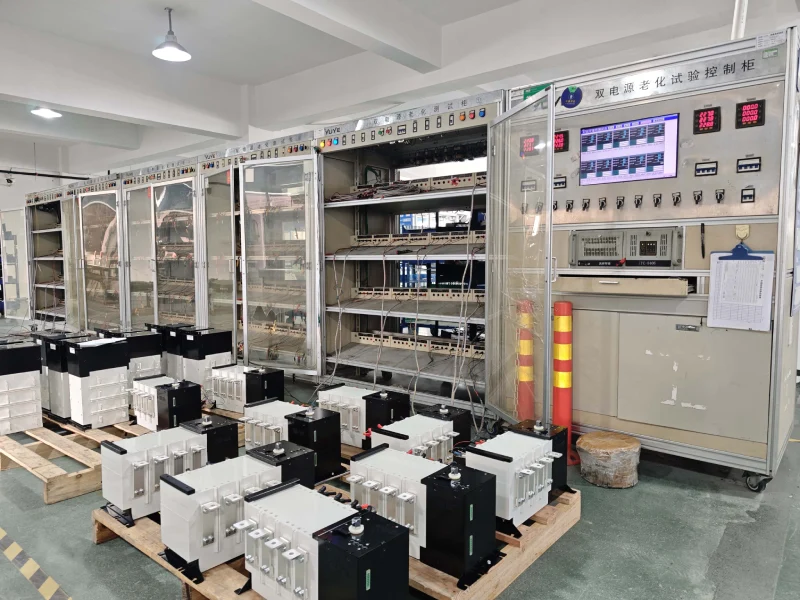The Generator That Made Everything Worse
Last winter, a small medical clinic invested $7,500 in a quality standby generator after years of storm-related outages disrupting patient care. They hired professionals, tested everything, and felt prepared.
Then the January ice storm hit. Power failed at 2 PM—peak patient hours. The generator started perfectly. But in the chaos of a packed waiting room and failing medical equipment, the office manager flipped the wrong breaker sequence. For just three seconds, both utility power and generator power connected simultaneously.
The backfeed surge destroyed $4,200 in diagnostic equipment, welded the transfer contacts, and sent dangerous voltage onto utility lines—endangering line workers restoring power.
The tragedy? Completely preventable. The clinic installed an interlock kit to save $2,000—but they needed an automatic transfer switch for their critical medical application. The wrong device for the wrong use case transformed their investment into disaster.
Why the Wrong Choice Causes Failures (And Why “Cheaper” Isn’t Always Cheaper)
The fundamental confusion about transfer switches vs. interlocks comes from a dangerous oversimplification: “They both do the same thing—prevent backfeed and switch power sources.”
That’s technically true. Both devices prevent the potentially lethal scenario where generator power feeds back onto utility lines, endangering utility workers and potentially destroying your generator and electrical panel. Both are code-compliant when properly installed. Both allow you to safely use a backup generator.
But saying “they both do the same thing” is like saying a bicycle and a car both provide transportation. Yes—but the contexts where each makes sense are dramatically different.
Here’s why the wrong choice creates problems:
The Manual Operation Trap
Interlock kits require you (or someone on-site) to manually perform a specific sequence of operations every time power fails: turn off the main breaker, slide the interlock plate, turn on the generator breaker, then manually manage individual circuit breakers to avoid overloading your generator.
In theory, this is simple. In practice, during a 2 AM outage in a freezing house with stressed family members, a sick child, or the chaos of a storm—human error becomes virtually guaranteed. A single mistake in that sequence can cause backfeed, overload your generator, or leave you without power despite having a working generator.
The Hidden Cost of “Cheap”
A typical residential interlock kit costs $150-400 plus $200-500 for installation—maybe $900 total. An automatic transfer switch costs $600-2,000 for the device plus $800-1,500 for installation—perhaps $2,500 total.
On paper, you “save” $1,600 by choosing the interlock. But that calculation ignores:
- The value of your time during every power outage (10-20 minutes per event)
- The risk of damage from incorrect operation (potentially thousands)
- The reality that you might not be home when power fails
- The requirement for every household member to know the correct procedure
The Application Mismatch Problem
This is the issue that destroyed the medical clinic’s equipment. Interlock kits are designed for residential applications where:
- Power outages are infrequent (a few times per year at most)
- Someone is always home and available to operate the system
- There’s no critical equipment that can’t tolerate 5-10 minutes of downtime
- Occupants can manage load by selectively turning circuits on and off
Automatic transfer switches are designed for applications where:
- Power must restore automatically without human intervention
- Critical systems (medical equipment, servers, refrigeration, security) can’t tolerate manual switching delays
- The location might be unoccupied when outages occur
- Load management needs to be pre-programmed and automatic
The clinic needed an ATS but installed an interlock to save $2,000. That “savings” cost them $11,700 in damaged equipment and lost productivity.
The Solution: A 4-Question Decision Framework
The answer isn’t that one device is “better”—it’s that each serves different needs. Instead of asking “which is best?” you need to ask four specific questions that will reveal which device matches your actual requirements:
Question 1: Can You Tolerate Manual Operation During Every Outage?
This is the foundational question that eliminates 80% of decision-making confusion.
Interlock Kit
Choose an Interlock Kit if you answer YES to all of these:
- Someone will always be home or can arrive within 15-30 minutes during outages
- You’re comfortable performing a 6-step manual procedure during stressful conditions
- Every adult in your household understands and can correctly execute the switching sequence
- You’re willing to manually manage circuit breakers to avoid overloading the generator
- You can tolerate 10-20 minutes between power loss and generator power delivery
VIOX Automatic Transfer Switch
You MUST choose an Automatic Transfer Switch if you answer NO to any of these:
- Your property might be unoccupied during outages (vacation home, rental, business)
- You have family members who cannot or should not operate electrical equipment (elderly, young children, disabilities)
- You need power to restore in under 30 seconds without human intervention
- Your application involves critical equipment (medical devices, server rooms, refrigeration, security systems)
- You experience frequent outages and don’t want to perform manual procedures weekly or monthly
Real-world example: A homeowner in Florida experiences 15-20 power outages per year during hurricane season. An interlock saves $1,800 upfront but requires manual operation 15-20 times annually. At 15 minutes per event, that’s 5 hours of manual labor per year. Over a 10-year period, that’s 50 hours—plus the stress and risk of errors during storms. The ATS “costs more” but delivers 300+ automatic transfers without any intervention.
💡 Principais conclusões: The real cost of an interlock isn’t the purchase price—it’s the ongoing “labor tax” you pay with your time and attention during every single power event for the next 10-20 years.
Question 2: What’s Your True Budget—Upfront Cost or Total Cost of Ownership?
Let’s break down the real economics with brutal honesty:
Interlock Kit Total Investment:
- Device: $150-400
- Professional installation: $200-500
- Total upfront: $350-900
- Annual maintenance: $0-50 (minimal)
- Time investment per outage: 15-20 minutes
- Risk premium for manual operation errors: Unknown but potentially catastrophic
Automatic Transfer Switch Total Investment:
- Device: $600-2,000 (residential), $2,500-8,000 (commercial)
- Professional installation: $800-1,500
- Total upfront: $1,400-3,500 (residential)
- Annual maintenance: $100-200 (testing, inspection)
- Time investment per outage: 0 minutes (fully automatic)
- Risk premium: Near-zero for quality units
The decision matrix:
| Scenario | 10-Year Cost: Interlock | 10-Year Cost: ATS | Better Choice |
|---|---|---|---|
| 2 outages/year, 5-minute response needed | $900 + minimal labor | $2,500 + $1,500 maintenance | ATS (speed required) |
| 5 outages/year, 15 minutes acceptable | $900 + 12.5 hours labor | $2,500 + $1,500 maintenance | Depends on labor value |
| 1 outage/year, weekend home | $900 (but won’t work if away) | $2,500 + $1,500 maintenance | ATS (unoccupied property) |
| 3 outages/year, always home, handy | $900 + 7.5 hours labor | $2,500 + $1,500 maintenance | Interlock (cost-conscious) |
Hidden cost most people miss: If you’re not home during an outage, your interlock provides zero value. You’ve invested $900 in a device that won’t help. If this happens just once, requiring a neighbor or property manager to manage generators and spoiled food, you’ve exceeded the cost difference.
🛠️ Dica Profissional: Calculate your “opportunity cost.” If power outages happen during work hours and you must leave work to drive home and operate the interlock, what does that cost in lost wages, client relationships, or productivity? For many professionals, a single missed work event exceeds the ATS cost premium.
Question 3: What Happens If You Get the Switching Sequence Wrong?
This is where interlock kits become truly risky for the wrong applications. The manual operation sequence for an interlock requires:
Correct 6-Step Procedure:
- Turn off the main utility breaker
- Turn off ALL individual circuit breakers
- Physically slide the interlock plate from “utility” to “generator” position
- Connect and start your portable generator (or confirm standby generator is running)
- Turn on the generator breaker
- Selectively turn on individual circuit breakers while monitoring total load
Each step has failure modes:
- Step 1 missed: Attempt to switch interlock while main is still on → mechanical binding or damage
- Step 2 missed: Leave heavy loads on → generator overload and shutdown on transfer
- Step 3 done incorrectly: Force the plate → damage interlock mechanism, lose safety lockout
- Step 5 done before Step 4: Attempt to energize panel with generator not ready → equipment damage
- Step 6 done carelessly: Exceed generator capacity → generator overload, voltage drop, potential damage to motors or electronics
During an emergency—storm, fire evacuation, medical crisis—expecting perfect execution of this sequence is unrealistic.
Automatic transfer switches eliminate this failure mode entirely. The ATS is pre-programmed for your specific installation and performs the switching sequence with exact timing:
- Detects utility power loss
- Verifies utility is truly down (delay prevents nuisance trips)
- Signals generator to start
- Monitors generator until stable voltage and frequency achieved
- Transfers pre-selected circuits in correct sequence
- Monitors for utility power restoration
- Transfers back only when utility is confirmed stable
- Signals generator cool-down and shutdown
No human decisions. No memory required. No stress-induced errors. Just automatic, correct operation every single time.
⚡ Nota crítica de segurança: Backfeed from incorrect interlock operation can kill utility workers. This isn’t theoretical—linemen die every year from energized lines they believed were de-energized. The legal and moral liability of causing injury through improper generator connection is a risk many property owners don’t adequately consider.
Question 4: Does Your Application Require Code-Mandated Automatic Transfer?
This is the question that removes choice from the equation. Many applications don’t just benefit from automatic transfer—they legally require it:
Automatic Transfer Switch Required by Code:
- Edifícios comerciais with emergency egress lighting per NFPA 101 (Life Safety Code)
- Instalações de cuidados de saúde including clinics, dental offices, urgent care (see NFPA 99)
- Buildings with fire alarm systems requiring backup power per NFPA 72
- Refrigerated food storage in commercial settings (health department requirements)
- High-rise residential buildings (local codes vary, typically buildings over 75 feet)
- Data centers or server rooms with SLA uptime commitments
- Elevators requiring backup power (accessibility codes)
- Assisted living facilities or any building housing vulnerable populations
Interlock Kits Generally Acceptable For:
- Single-family residential homes
- Small commercial buildings without life-safety systems
- Portable generator connections for temporary backup
- Agricultural or rural properties
- Workshops, garages, or outbuildings
Before you decide based on cost alone, verify your local electrical code. An inspection failure means paying for removal and replacement—turning your $900 “bargain” into a $3,500 mistake.
📋 Action Item: Call your local building department or consult with a licensed electrician BEFORE purchasing either device. Ask specifically: “For my application (residential/commercial), does code require automatic transfer or is a manual interlock acceptable?” Get the answer in writing.
Beyond the Basics: Understanding Hybrid Solutions and Advanced Considerations
Once you’ve worked through the four-question framework, a few edge cases and advanced options deserve attention:
Hybrid Approach: Manual Transfer Switch (Not an Interlock)
There’s a middle ground many people don’t know exists: a manual transfer switch (MTS). This is different from both an interlock and an automatic transfer switch:
- Like an ATS: It’s a dedicated transfer switch device (not just a sliding plate)
- Like an interlock: It requires manual operation
- The advantage: Simplified operation compared to interlocks—usually just a single lever from “utility” to “generator”
Manual transfer switches typically cost $300-800 plus installation, falling between interlocks and ATS in price. They’re excellent for:
- Cost-conscious installations where simplified operation is worth a modest premium over interlocks
- Portable generator connections where full automation isn’t justified
- DIY-friendly homeowners who want cleaner installation than interlock plates
Load Management Considerations
One critical difference often overlooked: interlocks allow you to power ANY circuit, enquanto automatic transfer switches power only PRE-SELECTED circuits.
With an interlock:
- You can manually choose which breakers to energize
- You can power your entire panel IF your generator is large enough
- You have flexibility but also responsibility—you must avoid overloading
With an ATS:
- The electrician pre-wires specific circuits (usually 6-10 critical circuits)
- These circuits transfer automatically
- You CANNOT easily power additional circuits without rewiring
For most applications, the ATS limitation is actually an advantage—it prevents overloading and ensures your most critical systems get power. But for some rural or workshop applications, the flexibility of the interlock is genuinely valuable.
Generator Type Compatibility
Your choice of switching device intersects with your generator type:
Portable generators
(Honda EU2200, Champion 3500, etc.):
- Work with both interlocks and manual transfer switches
- Generally NOT compatible with automatic transfer switches (ATSs need generator auto-start capability)
- Best practice: Interlock or manual transfer switch
Standby generators
(Generac Guardian, Kohler, Cummins):
- Designed for automatic operation
- REQUIRE automatic transfer switches for remote start signaling
- Using an interlock defeats the purpose of a standby generator
Inverter generators with ATS capability
(some newer models):
- Can work with simplified automatic transfer switches
- Verify compatibility before purchasing ATS
🔧 Compatibility Rule: If you have a permanently installed standby generator, you need an automatic transfer switch. If you have a portable generator you wheel out during outages, you need an interlock or manual transfer switch. Don’t cross these categories.
Installation Complexity and Permits
Both devices require:
- Licensed electrician installation (in most jurisdictions)
- Electrical permit and inspection
- Compliance with NEC Article 702 (Optional Standby Systems) or Article 700 (Emergency Systems)
However, complexity differs:
Interlock installation:
2-4 hours, minimal materials, straightforward inspection
ATS installation:
4-8 hours, additional wiring for selected circuits, more complex inspection
If you’re in a jurisdiction with slow permit processing, factor timeline into your decision. An interlock might be operational in a week; an ATS might require 2-3 weeks for planning, installation, and inspection.
Summary: The Right Device for the Right Application
After analyzing hundreds of backup power installations, the decision between automatic transfer switches and interlock kits follows predictable patterns:
Choose an Interlock Kit when:
- Your property is a single-family residential home with no special requirements
- You experience infrequent power outages (less than 5 per year)
- You’re using a portable generator you already own
- Someone capable will always be home or available within 30 minutes
- Budget is your primary constraint (under $1,000 total investment)
- You’re comfortable with manual operation and load management
- Local code permits interlocks for your application
Choose an Automatic Transfer Switch when:
- You have a permanently installed standby generator
- Your property might be unoccupied during outages
- You have critical equipment requiring uninterrupted power
- You experience frequent outages (5+ per year)
- Your application is commercial, medical, or involves life safety
- You value convenience and automatic operation
- You can invest $2,000-3,500 for residential or $5,000-10,000 for commercial systems
- Local code requires automatic transfer for your building type
Conclusão: Both devices solve the safety problem of backfeed prevention. The difference is operational: interlocks are manual and cheaper upfront; automatic transfer switches are automated and cheaper over time when you factor in convenience, speed, and reliability.
Don’t make the medical clinic’s mistake—choosing based on initial cost while ignoring the operational requirements of your application. A $1,600 savings that creates a $11,700 failure isn’t a savings at all.






